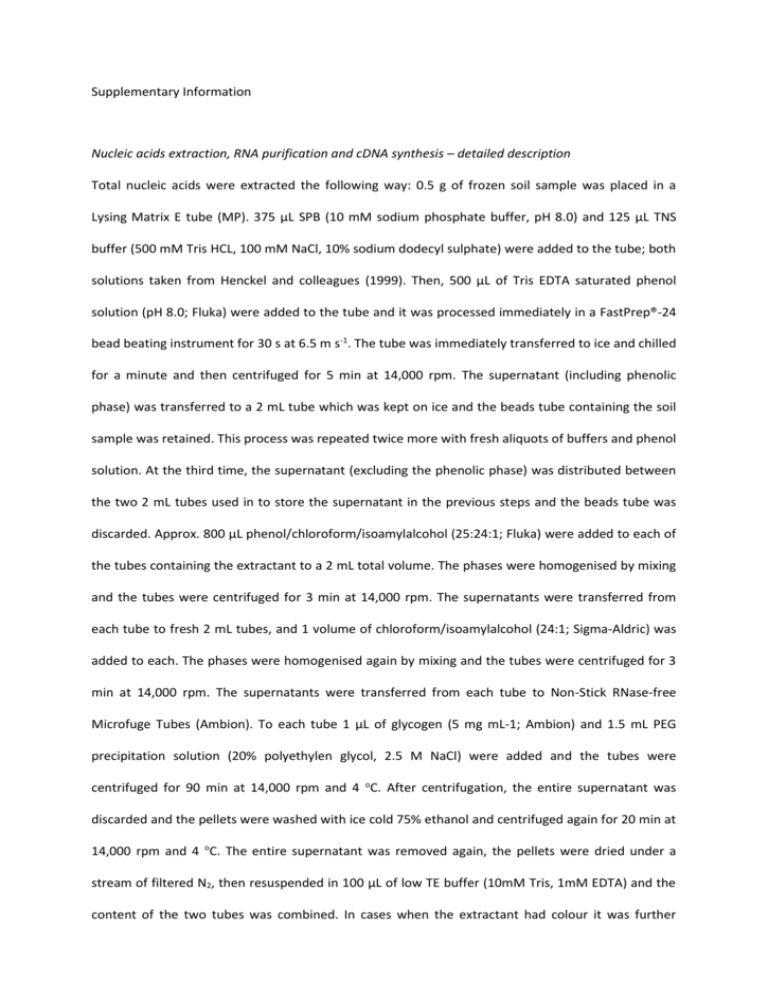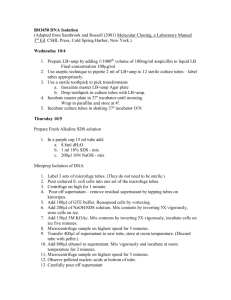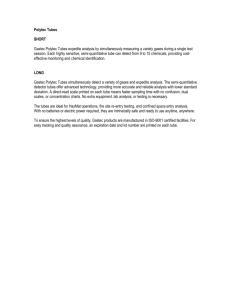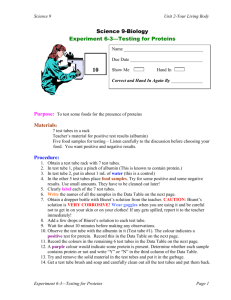Supplementary Information (doc 28K)
advertisement

Supplementary Information Nucleic acids extraction, RNA purification and cDNA synthesis – detailed description Total nucleic acids were extracted the following way: 0.5 g of frozen soil sample was placed in a Lysing Matrix E tube (MP). 375 µL SPB (10 mM sodium phosphate buffer, pH 8.0) and 125 µL TNS buffer (500 mM Tris HCL, 100 mM NaCl, 10% sodium dodecyl sulphate) were added to the tube; both solutions taken from Henckel and colleagues (1999). Then, 500 µL of Tris EDTA saturated phenol solution (pH 8.0; Fluka) were added to the tube and it was processed immediately in a FastPrep®-24 bead beating instrument for 30 s at 6.5 m s-1. The tube was immediately transferred to ice and chilled for a minute and then centrifuged for 5 min at 14,000 rpm. The supernatant (including phenolic phase) was transferred to a 2 mL tube which was kept on ice and the beads tube containing the soil sample was retained. This process was repeated twice more with fresh aliquots of buffers and phenol solution. At the third time, the supernatant (excluding the phenolic phase) was distributed between the two 2 mL tubes used in to store the supernatant in the previous steps and the beads tube was discarded. Approx. 800 µL phenol/chloroform/isoamylalcohol (25:24:1; Fluka) were added to each of the tubes containing the extractant to a 2 mL total volume. The phases were homogenised by mixing and the tubes were centrifuged for 3 min at 14,000 rpm. The supernatants were transferred from each tube to fresh 2 mL tubes, and 1 volume of chloroform/isoamylalcohol (24:1; Sigma-Aldric) was added to each. The phases were homogenised again by mixing and the tubes were centrifuged for 3 min at 14,000 rpm. The supernatants were transferred from each tube to Non-Stick RNase-free Microfuge Tubes (Ambion). To each tube 1 µL of glycogen (5 mg mL-1; Ambion) and 1.5 mL PEG precipitation solution (20% polyethylen glycol, 2.5 M NaCl) were added and the tubes were centrifuged for 90 min at 14,000 rpm and 4 oC. After centrifugation, the entire supernatant was discarded and the pellets were washed with ice cold 75% ethanol and centrifuged again for 20 min at 14,000 rpm and 4 oC. The entire supernatant was removed again, the pellets were dried under a stream of filtered N2, then resuspended in 100 µL of low TE buffer (10mM Tris, 1mM EDTA) and the content of the two tubes was combined. In cases when the extractant had colour it was further purified using MicroSpin S-200 HR (GE Healthcare). 10 µL of the extractant was diluted in 90 µL of low TE buffer and was used as DNA template. For synthesis of complete cDNA, 50 µL of nucleic acids extractant were digested with TURBO™ DNase (Ambion) and later purified using RNeasy® MinElute® Cleanup Kit (Qiagen) and quantified using a NanoDrop 1000 spectrophotometer (Thermo). Complete DNA removal was verified by failure to obtain PCR amplification product with the purified RNA template using the conditions described below. Complete cDNA was synthesized using ImProm-II™ Reverse Transcriptase (Promega) by the following procedure: 100 ng purified RNA and 0.5 µg/µL of random hexamer primers were incubated at 70°C for 5 min followed by 5 min chilling on ice. The following mixture was then directly added to the tubes: 4 µL of 5× ImProm-II™ Reaction Buffer, 3 mM MgCl2, 1 mM of each dNTP, 20 µg of bovine serum albumin (BSA) (Roche), and 20 U of Recombinant RNasin Ribonuclease Inhibitor (Promega). The reaction tubes were incubated at 25°C for 5 min followed by 52°C for 1 h, and then denaturation at 70°C for 15 min. The resulting cDNA product was used directly as a template for consecutive PCR reactions. PCR amplifications were performed identically for both DNA and cDNA templates. References Henckel T, Friedrich M, Conrad R. (1999). Molecular Analyses of the Methane-Oxidizing Microbial Community in Rice Field Soil by Targeting the Genes of the 16S rRNA, Particulate Methane Monooxygenase, and Methanol Dehydrogenase. Appl. Environ. Microbiol. 65:1980-1990.






